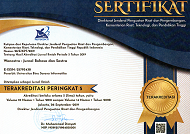Meme Sebagai Representasi Kritik dan kebebasan Berpendapat di Ruang Siber
Abstract
Abstrak - The purposes of this study is to describe what and how memes in social media Instagram as the representation of critics from netizen. The approach of this study is Critical Discourse Analysis by Fairclough with three dimensions; text, discursive practice, and social practice. The writer chooses meme in @fakartun Instagram account as the data source because meme full of funny picture and simple text, easy to understand, and lead the reader to think twice to find the implied meaning in it. This research is focused on meme in @fakartun Instagram account, especially pictures, text, and caption. The conclusion of this study is the writer found social media as a space for netizen to get and upload many information widely and effectively. Nowadays memes are no longer just pictures and funny words that are entertaining but become a media to express opinions, criticize a policy or an event that is happening. Finally, the findings of this analysis will describe how the patterns of opinion, commenting, and critical thinking of citizens in cyberspace
Keywords: Critical Discourse Analysis, Fairclough, memes, Instagram, @fakartun
Full Text:
PDF (Bahasa Indonesia)References
Bauchkage, C. (2011). Insight into Internet Memes. Proceedings of the Fifth International AAAI Conference on Weblogs and Social Media, 42–49.
Dawkins, R. (2006). Selfish gene. In New Scientist (anniversar, Vol. 214). https://doi.org/10.1016/S0262-4079(12)61286-X
Fairclough, N. (1995). Critical Discourse Analysis: The Critical Study of Language. London: Longman.
Ku, K. Y. L., Kong, Q., Song, Y., Deng, L., Kang, Y., & Hu, A. (2019). What predicts adolescents’ critical thinking about real-life news? The roles of social media news consumption and news media literacy. Thinking Skills and Creativity, 33(May), 100570. https://doi.org/10.1016/j.tsc.2019.05.004
Liputan6.com. (2019). 6 Aksi Protes Netizen Lawan Kabut Asap Karhutla, Bikin Terenyuh. https://hot.liputan6.com/read/4064660/6-aksi-protes-netizen-lawan-kabut-asap-karhutla-bikin-terenyuh.
Listiyorini, A. (2017). WACANA HUMOR DALAM MEME DI MEDIA ONLINE SEBAGAI POTRET KEHIDUPAN SEBAGIAN MASYARAKAT INDONESIA. Litera, 16 no. 1, 64–77.
Pusanti, R. R. (2015). Representasi Kritik Dalam Bentuk Meme Politik. Jurnal Komunikasi Massa, 1, 1–19.
Saifullah, A. R. (2016). Issues of terrorism on the internet in the wave of democratization of post-reform Indonesia: A semiotic analysis. Indonesian Journal of Applied Linguistics, 5(2), 307–315. https://doi.org/10.17509/ijal.v5i2.1354
Saryono. (2010). Metodologi Penelitian Dalam Bidang Kesehatan. Yogyakarta: Nuha Medika.
Shifman, L. (2013). Memes in a digital world: Reconciling with a conceptual troublemaker. Journal of Computer-Mediated Communication, 18(3), 362–377. https://doi.org/10.1111/jcc4.12013
sudarsono, S. C. (2017). Representasi Masyarakat Indonesia yang Tecermin Melalui Ketidakjujuran dalam Wacana Humor Meme Awas Itu Hoax. 21–25. Jakarta: KOLITA 15.
Zubaidah, Neneng and Ardelia, I. (2018). A DISCOURSE ANALYSIS OF MEMES. Getsempena English Education Journal (GEEJ), 5(2), 58–64.
DOI: https://doi.org/10.31294/w.v12i1.7189
Copyright (c) 2020 Prapti Wigati Purwaningrum

This work is licensed under a Creative Commons Attribution-ShareAlike 4.0 International License.
Index by:
Published by Department of Research and Community Service (LPPM) Universitas Bina Sarana Informatika by supported Relawan Jurnal Indonesia
Jl. Kramat Raya No.98, Kwitang, Kec. Senen, Jakarta Pusat, DKI Jakarta 10450

This work is licensed under a Creative Commons Attribution-ShareAlike 4.0 International License






